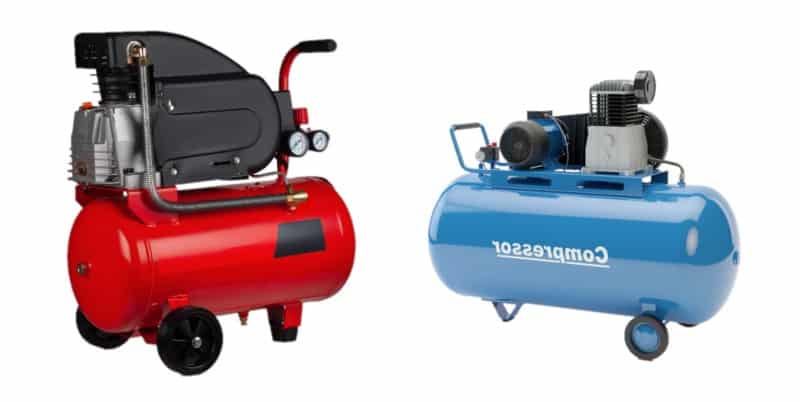
Air compressor is one of the most important appliances with numerous uses in the industrial sector, manufacturing units, powering ships and planes and even considered as an essential household appliance. The basic function of any air compressor is to produce power for electronic devices. However, it has many different types and each type has its own unique functionality and utility. Over the years different types of compressors are produced in order to fulfill different types of needs and requirements. For example, to give pressure to the engine of a plane may require a very high-speed compressor, whereas, for constructing houses, one may need a relatively smaller compressor. Thus, all these types of air compressors come with their own sets of pros and cons.
Types of Air Compressors
Air compressors are divided into two broad categories, which have further two types each.
1. Positive Displacement
These are the type of air compressors that produce power through air displacement. Although positive displacement compressors have further types as well, the basic mechanism is the same for all, which is to store the air from outside and compress it slowly to increase air pressure and energy. Positive displacement compressors have further two types.
a) Rotary Screw Compressor
These are the most basic type of air compressors as they have an internal cooling system and require less or no maintenance, therefore, can be used on a continuous basis. The two rotors in this compressor run in the opposite direction and generate pressure and energy. Rotary screw compressors are mostly used in the industrial sector as they are huge in size and often run with or without oil. The horsepower of rotary screw compressors ranges from 5 to 350 only. The rotary compressor has further three types as well:
- Vane
- Scroll
- Lobe
b) Reciprocating Compressor
Another type of positive displacement compressor is the reciprocating compressor. They are made for smaller sites, such as house construction, garages, house renovation, etc. A reciprocating compressor cannot be used on a continuous basis, unlike the rotary screw compressor. The reciprocating compressor has more parts as compared to the rotary compressor and these parts need to be lubricated before use. So reciprocating compressors are operated with oil. These compressors work through piston inside a cylinder, which compresses air and builds up the pressure.
Reciprocating compressors also come in single or multi-stage variations in order to achieve different pressure ranges. Single-stage compressors are used for smaller tasks and projects like woodworking or metalworking. Whereas, a multi-stage compressor produces a high amount of power and energy, therefore, it can be used for bigger tasks such as assembly and maintenance. These are the most common type of compressors and widely used by the construction companies and have the horsepower of multi-stage compressors goes up to 30 only.
2. Dynamic Displacement
Dynamic compressors produce horsepower by bringing the air with rapidly moving blades and then confining the air in order to build up the pressure. Then it stores the kinetic energy as static inside the compressor itself. The following are the types of dynamic displacement compressors.
a) Axial Compressors
Axial compressors are made to run engines of ships and planes, as they are very high-speed. They are not used in the industrial sector, manufacturing or construction sites. These are the most expensive types of air compressors as they have high-efficiency rate and can go up to thousands of horsepower to generate pressure and energy.
b) Centrifugal Compressors
Centrifugal compressors are smaller in size but have the capacity to produce a high amount of pressure and energy. Centrifugal compressors basically slow and cool down the air coming from outside through a diffuser to produce the required energy. These types of compressors require the least amount of maintenance as most of them are even capable of running without oil. They can go up to 1000 horsepower, therefore, they are suitable for high demanding construction sites, including, chemical plants and steel manufacturers.
How to Choose the Right Type of Air Compressors?
Above listed air compressors are used for different purposes and one should always consider their requirements before going for an air compressor. Consider the following factors before making a choice, aside from horsepower and energy-producing rate:
Quality of Air
Some manufacturing sites do not allow compressors that are operated with oil as they have to ensure a clean environment. Therefore, these sites have to go for oil-free compressors despite the fact that they are very expensive. The air quality of the oil-free compressor is very clean and also their maintenance cost is very low because its parts do not require cleaning and changing.
Efficient usage of Energy
Always consider a compressor with efficient energy output for a long on-going construction project. Although these types of air compressors are also expensive and extra money spent is worth in the long run. Energy-efficient compressors use less oil and require less or no amount of maintenance.
Portable Compressor
If the compressor needs to be used at different sites, then it should be portable and easy to handle. Although these types of compressors may not be able to produce a huge amount of energy as compared to large compressors, they work well for smaller projects. Also moving one compressor to multiple sites saves cost as compared to buying a compressor separately for each site.
In addition to the mentioned features above, always go for additional features that a compressor has to offer or is compatible with, in order to make the best choice. The more features a compressor has, the more utility it is going to have in the long run. Some compressors come with belt-drive systems that allow noiseless operation. Whereas, some have insulation which keeps the internal heating on track and protects the machine against damages. Such add-on features can help with the functionality of the compressor.
Related Video:
